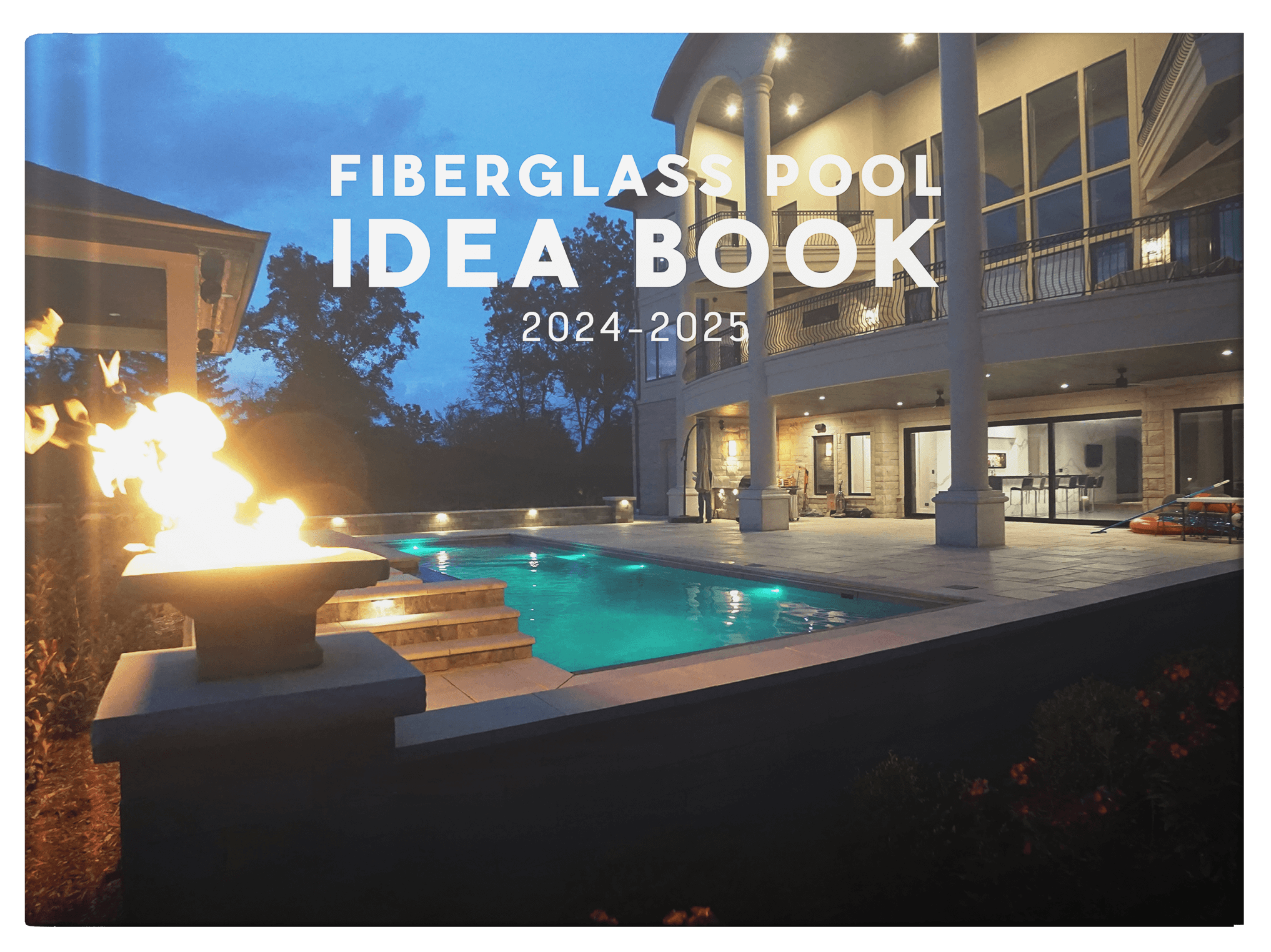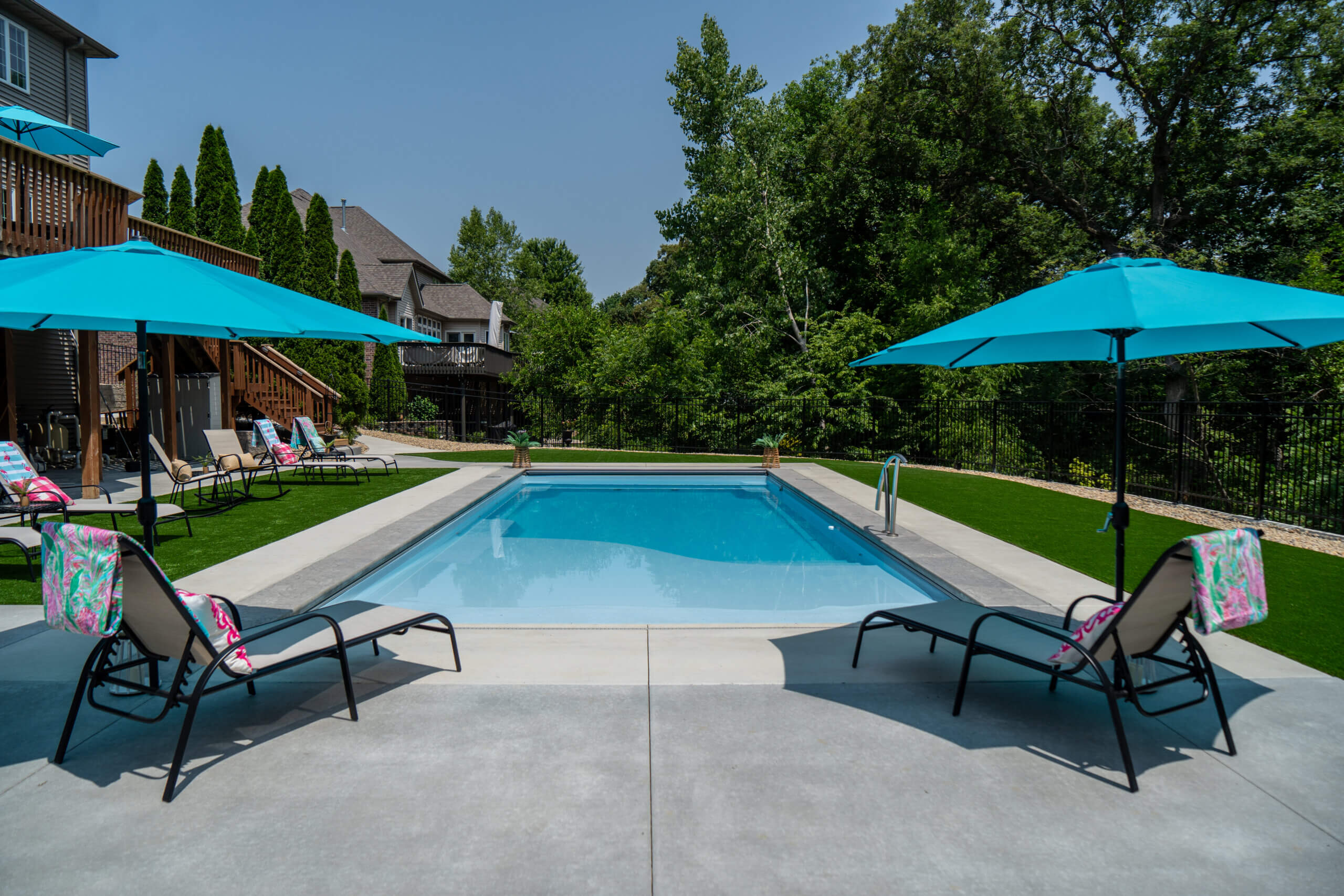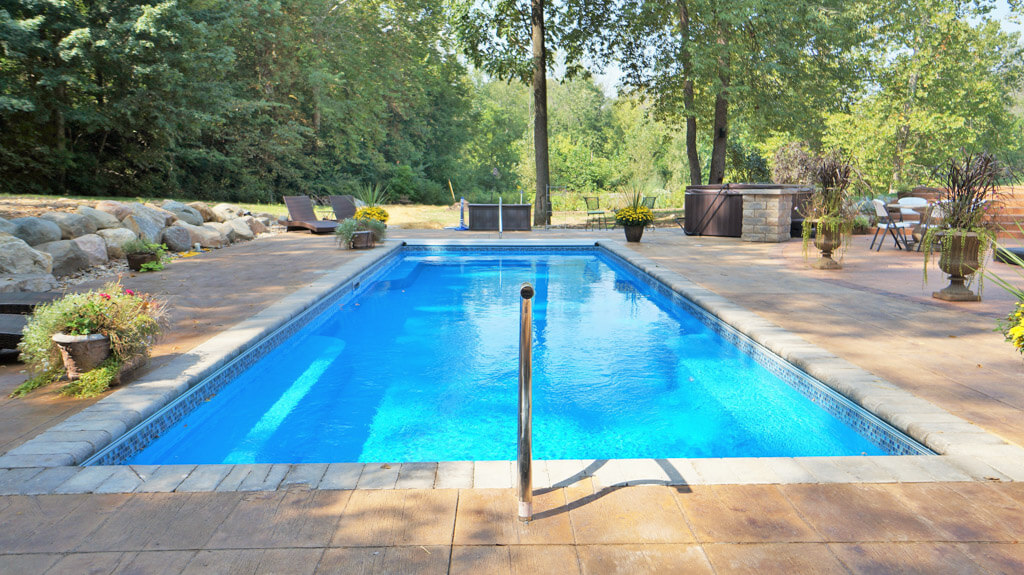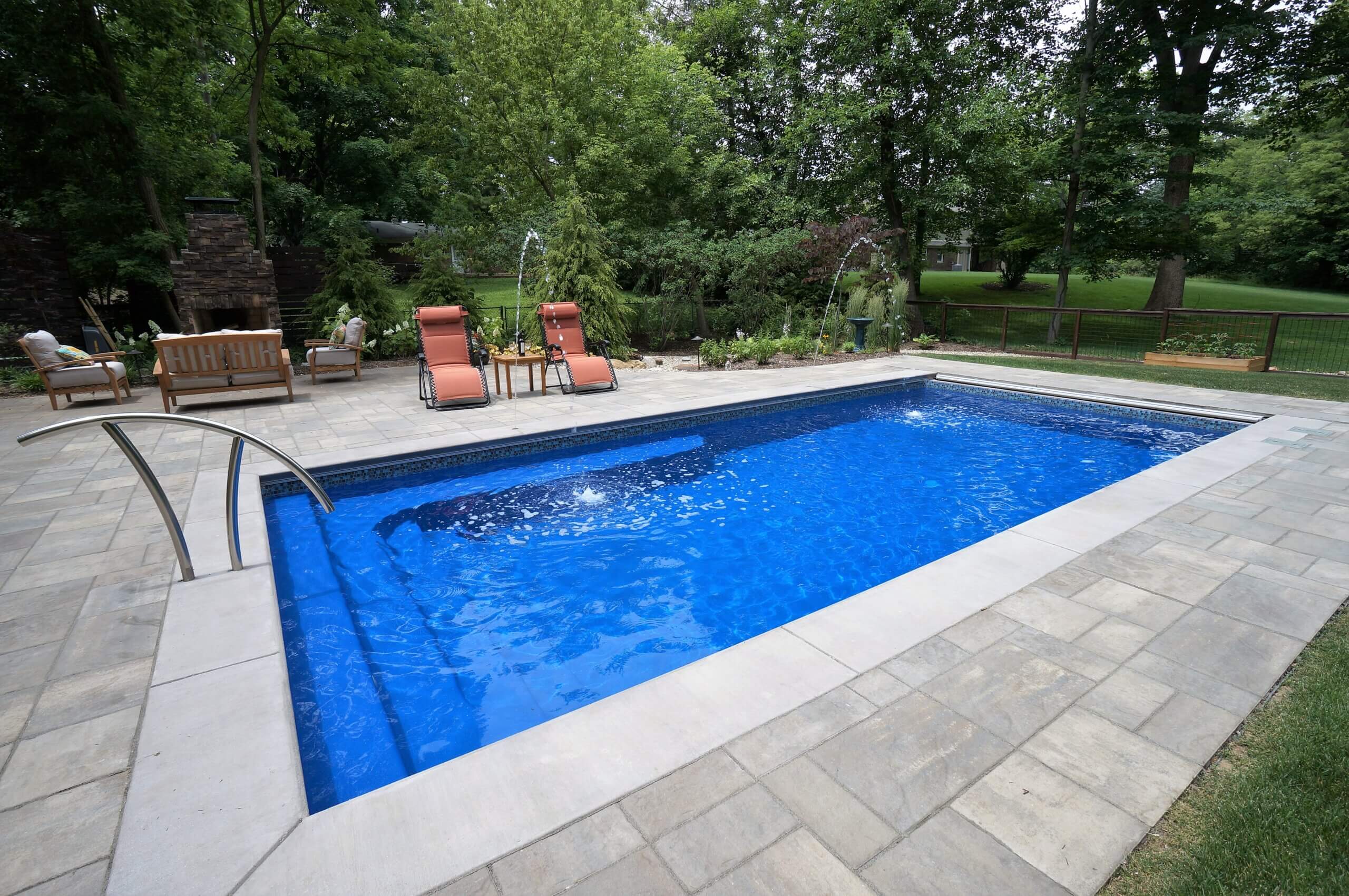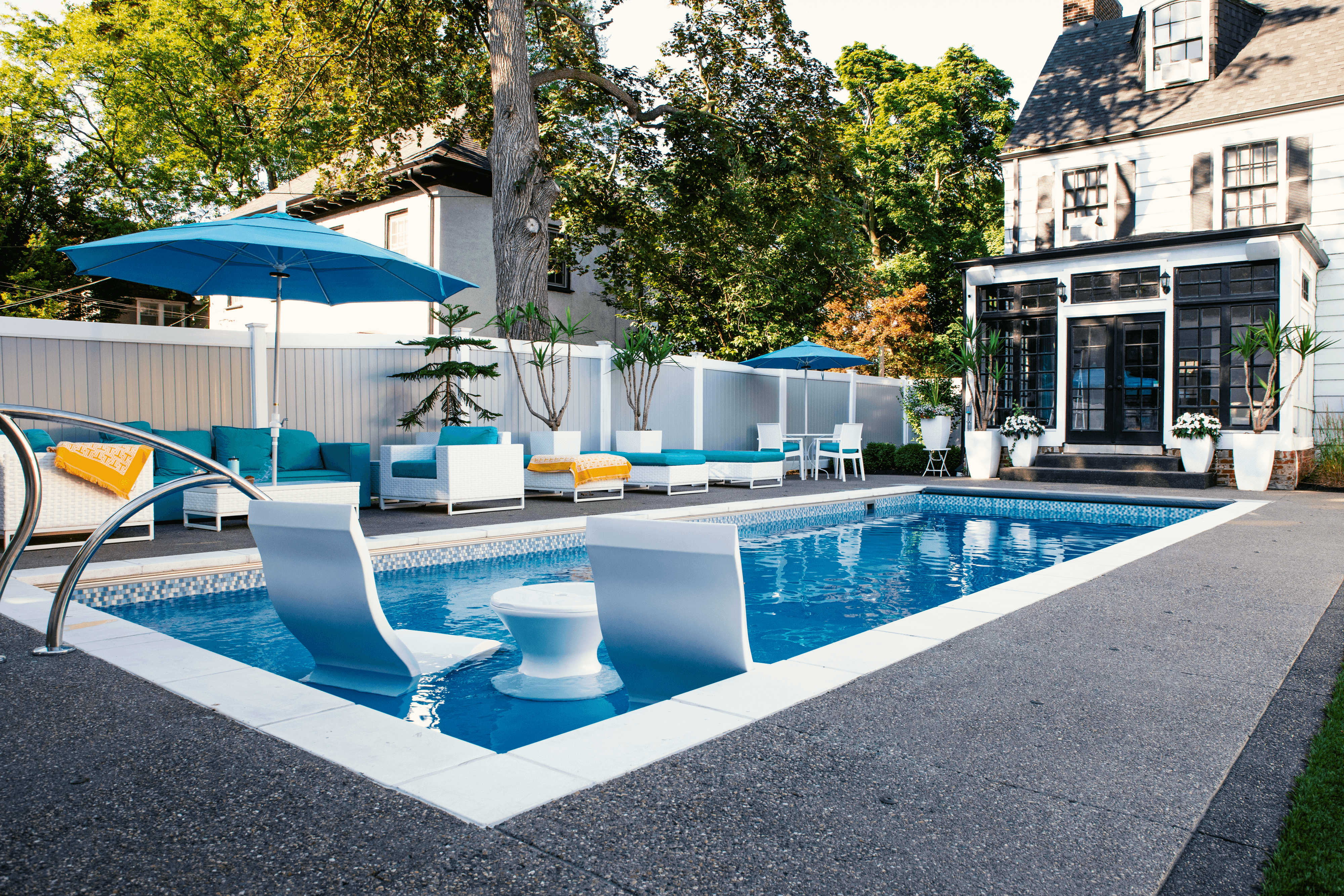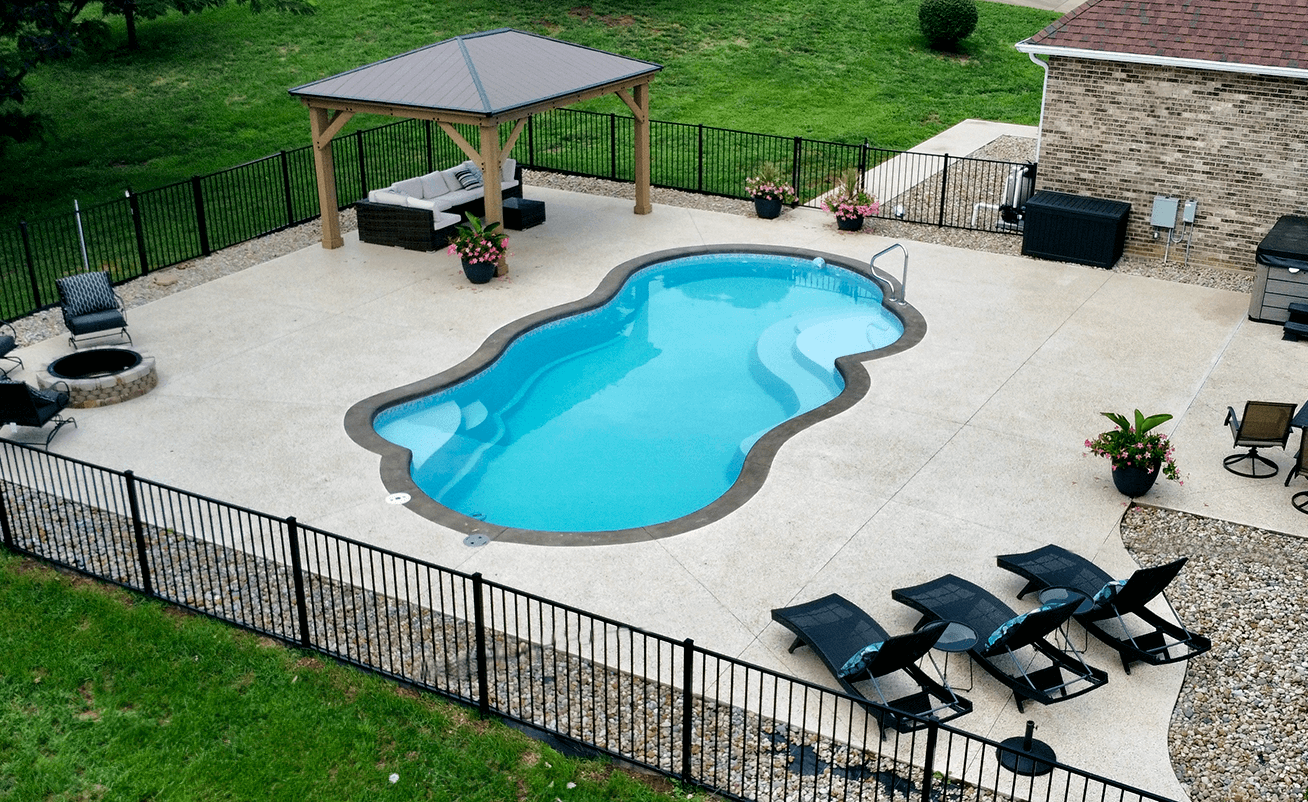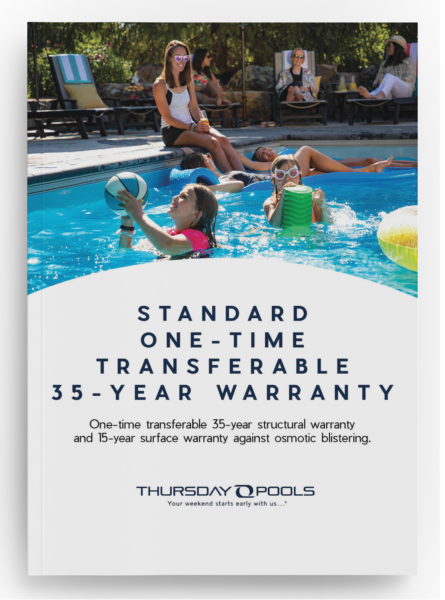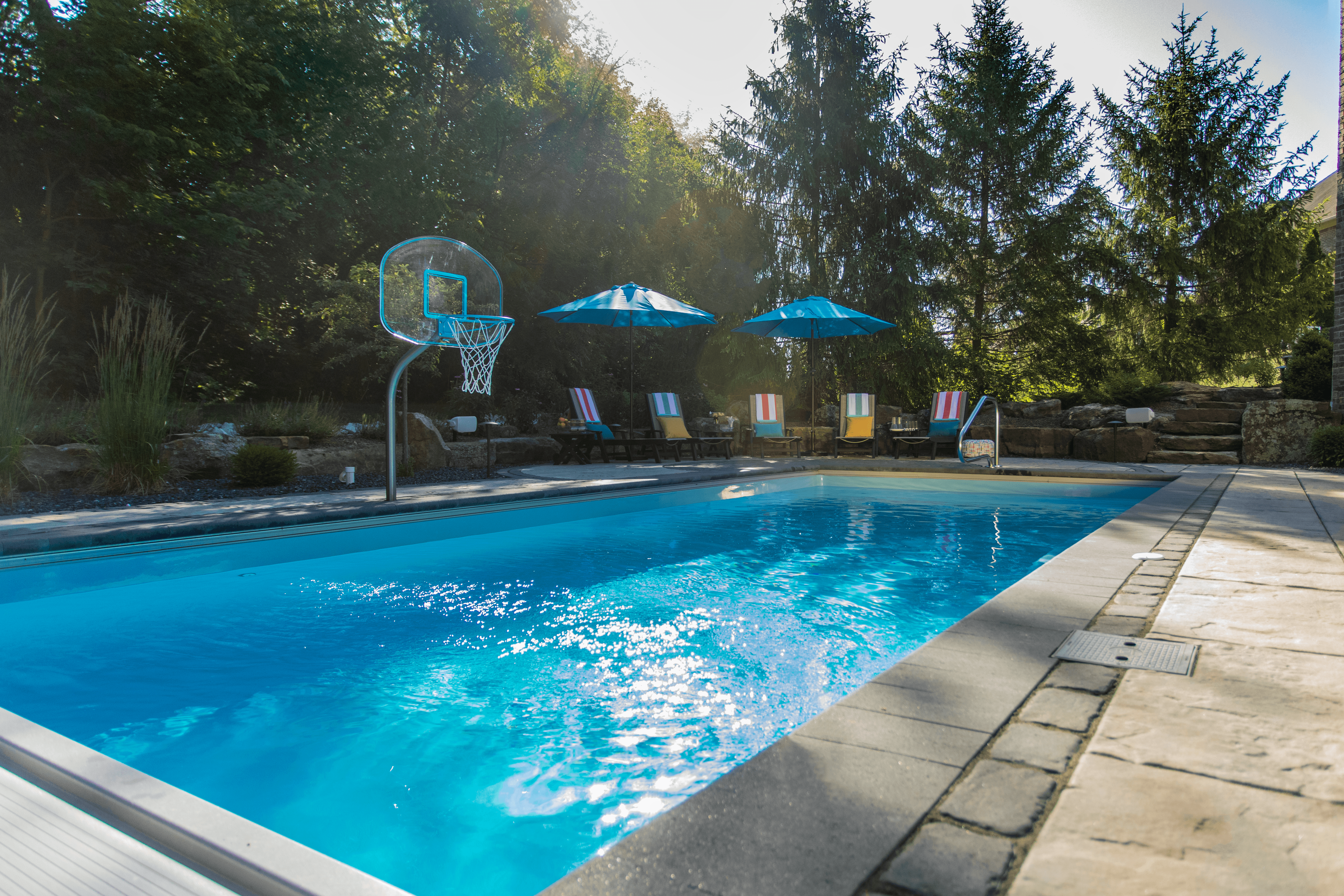Topic: Fiberglass Pools
How to Protect Your Pool Water Balance During the Off-season
As the vibrant days of summer fade into the crisp air of autumn, fiberglass pool owners face the critical task of preparing their pools for the off-season. However, the upcoming period of dormancy does not equate to a halt in maintenance efforts. Instead, the off-season requires a strategic approach to ensure your pool water is neither corrosive nor scaling and will be ready for the next swimming season. Smart homeowners must understand the essential steps for monitoring the pool’s water chemistry balance during the colder months to safeguard against potential damage that winter can bring.
Water Chemistry Challenges in the Off-Season
Fiberglass pools, celebrated for their durability and longevity, are not immune to all the challenges of changing seasons. Fiberglass pool shells are generally resilient against winter conditions thanks to their flexibility, which can withstand stress from freezing temperatures. However, harsh winter conditions can still threaten the water balance and the pool surface if you do not properly winterize the pool. The risk of damage escalates during winter when colder water temperatures can render the water more aggressive. This aggressiveness primarily stems from the water’s chemistry balance shifting with temperature changes, potentially leading to issues that can compromise the integrity of your pool’s finish.
Seasonal Cleaning and Preparation
The first step in your off-season maintenance routine should be thoroughly cleaning your pool. End-of-season cleaning includes wiping down the waterline with a soft brush to eliminate any buildup of debris, sunscreen, body oils, and other contaminants that may have accumulated over the swimming season. Brush all pool surfaces, paying extra attention to corners and steps where algae and bacteria might accumulate. Remove all leaves, debris, and dirt from the water using a skimmer, and vacuum the pool thoroughly to eliminate any settled particles or algae. A clean pool goes beyond attractive aesthetics to create a stable foundation for your off-season water balance efforts.
The Role of a Pool Cover
Investing in a high-quality pool cover offers multiple benefits throughout the year, with its importance magnified during the off-season. A pool cover acts as a barrier against debris, reduces water evaporation, and helps maintain the pool’s water chemistry balance by minimizing external influences.
Especially important for households with children or pets, a properly secured winter pool cover can also prevent accidental falls into the pool. Safety covers can withstand a person’s weight, providing an extra layer of protection when the pool is not in use. More than a convenience, a pool cover offers peace of mind and ensures your pool remains clean, sealed, and safe throughout the winter.
Enjoy the Benefits of Proactive Off-Season Maintenance
The effort you put into off-season maintenance directly impacts the longevity and condition of your fiberglass pool. By taking steps to clean your pool, adjust its water chemistry for the cold, periodically check its balance, and secure it with a pool cover, you protect your investment and make for an easier and more efficient opening in the spring.
A proactive approach ensures your pool remains a source of enjoyment and relaxation for many years without extensive repairs or adjustments when the swim season arrives. Embrace the off-season as an opportunity to ensure your fiberglass pool’s continued health, beauty, and enjoyment.
Frequently Asked Questions About Off-Season Pool Water Chemistry
Why is water chemistry so important during the off-season?
Cold water can shift your pool’s chemistry and become more aggressive. Keeping pH, total alkalinity, and calcium in check, and routine use of a stain and scale product, helps protect your fiberglass surface and equipment throughout the winter months.
Do I need to clean my pool before closing for the season?
Yes. A thorough cleaning is essential. Brush all surfaces, skim, and vacuum to eliminate algae, dirt, and debris. A clean pool sets the stage for stable water chemistry all winter long.
What role does a pool cover play in off-season maintenance?
A high-quality pool cover keeps debris, dirt, and leaves out of the water, reduces evaporation, and helps preserve your pool’s chemical balance. Covers make winter care easier and spring openings faster.
Should I check my pool’s water chemistry during the winter?
Yes. Weather permitting, check the water’s balance periodically. Cold water’s chemistry can still shift over time, and making small adjustments ensures it remains stable. Regular checks prevent surprises at spring opening and help extend the life and beauty of your fiberglass pool.
What are the most common mistakes pool owners make during the off-season?
The biggest mistakes include failing to balance water chemistry for colder temperatures, skipping a thorough cleaning before closing, and not using a quality pool cover. Neglecting these steps can lead to algae growth, staining, scaling, or corrosion that makes spring opening more difficult and costly.
How does proper off-season care make spring opening easier?
When you clean, balance, and cover your pool correctly before winter, you prevent debris buildup and chemical imbalances. That means fewer surprises—like cloudy water, stains, or equipment issues—when you reopen. A proactive approach saves time, reduces costs, and helps you start swimming sooner in the spring.
What Does Routine Fiberglass Pool Maintenance Look Like?
Owning a fiberglass pool brings with it the benefits of reduced upkeep demands and the guarantee of continuous enjoyment during the warmer months. Yet, it’s crucial to recognize that this ease of ownership is complemented by the need for consistent maintenance, particularly in maintaining balanced pool water chemistry, to ensure your pool remains a radiant and inviting space to spend time with your family and friends. This post examines what routine fiberglass pool maintenance entails and guides you through a plan to keep your pool in perfect harmony throughout the swimming season.
Starting the Season Right
Opening your fiberglass pool marks the commencement of the swimming season and sets the stage for a season of fun and relaxation. Once you open your pool, commit to conducting daily tests to adjust your pool’s chemistry until the water’s Langelier Saturation Index (LSI) value is balanced (-0.30 to +0.30). This crucial first step ensures your pool water is neither too corrosive nor scaling, protecting the integrity and appearance of the fiberglass gel coat.
Maintaining Chlorine Levels
Once the LSI is in balance, the next step is to add sanitizer to maintain chlorine levels within a safe range of 1 to 3 parts per million (ppm). This range is optimal for disinfecting the pool without damaging the fiberglass surface. Monitoring and adjusting chlorine levels is a fundamental aspect of routine maintenance that keeps the water clear, clean, and safe for swimmers.
Weekly Checks and Adjustments
Your pool’s water chemistry can quickly fluctuate even after establishing a balanced baseline due to various events such as changes in swimmer load, weather conditions, organic debris, water evaporation and more. Perform weekly tests to ensure ongoing water balance, checking the chlorine, pH, alkalinity, and other factors contributing to the LSI. These regular check-ins help catch and correct minor imbalances before they become bigger issues.
Water Level and Filtration Maintenance
Maintaining the pool’s water level is another vital aspect of routine care. The water level should always be halfway to the top of the skimmer window to ensure efficient filtration and circulation. Regularly check and clean the filter and skimmer baskets to prevent clogs and maintain proper function. Additionally, vacuuming your pool to remove debris and sediment keeps the water clearer and reduces the strain on your pool’s filtration system.
Gentle Cleaning for Long-Lasting Shine
The non-porous gelcoat surface of fiberglass pools is highly stain-resistant, making cleaning a breeze. A soft microfiber cloth, sponge, or pool brush with nylon bristles should suffice. Some household cleaners contain harsh chemicals unsuitable for fiberglass pool surfaces and may cause damage over time. Always use cleaners specifically designed for fiberglass pools as aggressive cleaning agents can damage the gelcoat, leading to unnecessary wear and repair costs. Metal scrapers or putty knives can gouge or scratch the fiberglass when used to remove debris or scale. Also avoid using highly abrasive tools such as wire and stiff bristle brushes or steel wool.
The Value of Prevention
In pool maintenance, an ounce of prevention is worth a pound of cure. Regular, proactive care keeps your pool looking and performing its best and extends the life of your investment. Fortunately, the inherent durability and ease of care associated with fiberglass pools mean that maintaining balanced water chemistry requires less effort than you might think. Test kits and tools such as the Orenda LSI calculator smartphone application can help by quickly providing direction on how to properly balance your pool water.
Understanding Low Maintenance Isn’t Maintenance-Free
While fiberglass pools are celebrated for their low maintenance needs, it’s important to remember that “less maintenance” doesn’t mean “maintenance-free.” The foundation of a healthy, long-lasting pool is balanced water chemistry, achieved through frequent and routine testing, precise adjustments, and regular cleaning. By embracing these responsibilities, you’ll ensure your pool remains a beautiful source of joy, relaxation, and pride.
Routine fiberglass pool maintenance, centered around balanced water chemistry, is the cornerstone of a healthy, beautiful pool. By beginning the season with thorough testing and adjustments, maintaining chlorine levels, weekly checks, keeping the pool clean, and proactively managing the water balance, you can enjoy a trouble-free swimming experience.
Five Essential Steps to Maintain Your Pool’s Finish
For many homeowners, the benefit of reduced maintenance responsibilities is influential in their decision to install a fiberglass pool in their backyard. The non-porous surface of a fiberglass pool significantly lessens the likelihood of algae growth and reduces the demand for chemicals to maintain water balance. This inherent characteristic of fiberglass pools substantially contributes to their appeal, offering homeowners more time to enjoy their aquatic sanctuary with less laborious upkeep. However, it’s crucial to understand that “lower maintenance” does not equate to “maintenance-free.” Maintaining your pool’s vibrant, smooth finish is just as important as keeping the water clear and inviting. While the allure of crystal-clear water is undeniable, the unseen balance of water chemistry plays a crucial role in preserving the integrity and appearance of your pool.
Step 1: Use a Stain and Scale Control Product Regularly
Even well-balanced water can carry minerals that deposit on your pool’s surface, leading to staining or scale buildup. A reliable stain and scale control product helps prevent fiberglass pool discoloration with chelating agents that can effectively shield your pool from calcium. In our experience, products like SC-1000 by Orenda and Scale & Stain Eliminator by Pool Stain Removers work well and should be part of your regular pool maintenance routine.
Step 2: Maintain Chlorine Levels Between 1-3 ppm
Chlorine protects your pool from harmful bacteria and algae. While chlorine is essential, too much can harm your pool’s finish. Keep free chlorine between 1 and 3 ppm. Beware of exceeding 5 ppm, as high chlorine levels can cause irreversible damage to your pool’s surface, leading to discoloration and degradation of the gelcoat.
Step 3: Avoid Calcium Hypochlorite
While calcium hypochlorite is common in various pool contexts for shock treatments, it poses risks for fiberglass pool surfaces due to its propensity to elevate pH levels and deliver a high dose of free chlorine. Liquid chlorine is a preferable alternative, offering a safer means to manage pool hygiene without the associated risks of calcium hypochlorite. Nevertheless, vigilance is required to prevent the adverse effects of excessive chlorine, ensuring the pool’s surface remains pristine.
Step 4: Keep pH Between 7.2 and 7.4
Maintaining a pH range between 7.2 and 7.4 keeps your chlorine effective and protects the pool’s surface. A pH above 7.8 can contribute to scaling and discoloration, while a pH that’s too low can lead to etching. Regular testing and adjustments help keep this critical pool maintenance parameter within range.
Step 5: Maintain Calcium Hardness Below 120 ppm
Fiberglass pools don’t need the same high calcium levels as concrete pools. Keeping calcium hardness less than 120 ppm helps prevent scale buildup and maintains the beauty of your surface finish. Do not add calcium-based products. If your water’s calcium hardness is greater than 120 ppm, use a chelating stain and scale control product to prevent scaling and discoloration.
Bonus Tip: Don’t Assume Your Pool Pros Know it All!
The pool maintenance industry is constantly evolving, with new products and refined best practices emerging regularly. As a pool owner, staying informed about these developments is beneficial to ensure your pool receives the best care possible.
Engage with your pool maintenance professionals and inquire whether they are familiar with specific parameters for fiberglass pools. Fiberglass pools are unique, and maintenance pros should treat them as such.
By following these five essential tips and staying on top of your water chemistry, you’ll protect your pool’s beauty and performance for years to come. Pool ownership is a journey. When you have the right knowledge, it’s a journey you can enjoy with confidence.
Looking for more information on fiberglass pool care? Explore Thursday Pools’ Ultimate Fiberglass Pool Maintenance Guide for a thorough look at everything you need to know.
And if you’re ready for personalized advice, connect with a local independent Thursday Pools dealer near you.
Frequently Asked Questions About Maintaining a Fiberglass Pool Finish
How do I protect my fiberglass pool’s finish?
Test your water often, keep chlorine between 1-3 ppm, maintain pH between 7.2-7.4, and use a stain and scale control product that chelates calcium. These steps prevent discoloration, scaling, and surface damage.
Why should I avoid calcium hypochlorite in a fiberglass pool?
Calcium hypochlorite raises pH and delivers a strong chlorine dose that can harm your pool’s gelcoat. Use liquid chlorine instead to sanitize safely.
What calcium hardness level works best for fiberglass pools?
Keep calcium hardness below 120 ppm. Higher levels can cause scale buildup and discoloration. Use a stain and scale control product that chelates calcium if you have naturally hard water with high calcium hardness, such as SC-1000 by Orenda or Scale & Stain Eliminator by Pool Stain Removers.
Does clear water always mean my pool water is balanced?
No. Water can look crystal clear but still be corrosive or scaling. Always test and adjust based on the LSI balance, especially as water temperature changes.
Should I rely on a pool service professional for water balance?
Stay informed and ask questions. Fiberglass pools require specific care, and not every pool professional knows the latest best practices. Double-check your pool’s water chemistry balance yourself regularly.
Fiberglass Pool Water Chemistry
Help ensure the longevity of your fiberglass pool by practicing proper pool water chemistry. Learn how to safeguard your pool from damage with expert insights and tips.
Warranty
Large and Deep Fiberglass Pool Options
Pool owners love fiberglass pools for many reasons. Fiberglass pools are low-maintenance, quick to install and require fewer chemicals. Because fiberglass pools don’t have liners to replace or concrete that will eventually need to be replastered, they have the lowest lifetime cost of ownership over vinyl and gunite pools. They also have a smooth, durable finish that’s totally pet friendly, making them a sure bet for everyone in the family to love.
So why would anyone choose anything other than fiberglass? Well, there really aren’t too many reasons! However, for pool buyers looking for a large inground pool, the options in fiberglass are somewhat limited. Whereas gunite and vinyl pools are built on-site, fiberglass pools are made in a factory, out of a mold, and then transported in one piece to the home of their lucky new pool owners. There’s a limit to the size of what can be safely loaded, unloaded and transported, and on-site physical barriers like fences and trees also have to be taken into consideration for delivery.
Alas, there are some large fiberglass pool options that allow swimming pool owners the best of both worlds–big and low-maintenance. For your convenience, we have created comparison charts of large pools by various manufacturers in both rectangular and freeform shapes. While there are many similarities, certain aspects may be more appealing to you.
While large and deep fiberglass pools offer more than ample swim area for families, not everyone needs that much depth. If you want a pool that’s still generously sized but maybe not quite so deep, check out Thursday Pools models like Goliath, Aspen, or the Cathedral LX. With so many amazing options to choose from, you’re sure to find the perfect pool for you!
What Can Damage a Fiberglass Pool?
It’s easy to get caught up in the excitement of something new. Whether it’s a car, a boat, or an inground swimming pool, it’s only natural to want to do as much research as possible before signing on the dotted line. You’ll want to know how long it’ll last, right? If you’re currently considering an inground fiberglass pool and trying to cover all your bases, you may have searched for potential problems such as, “What can damage a fiberglass pool?” and “Can you scratch a fiberglass pool?” Perhaps you’ve also looked up fiberglass pool gelcoat problems and fiberglass pool bulging walls. This post covers a few common concerns you may have heard regarding fiberglass pools, how they happen, and if you can prevent them or repair them if they occur.
How Does Fiberglass Pool Chemistry relate to these issues?
A big part of the longevity of your fiberglass pool is the water chemistry. Water chemistry can be tricky for any pool owner, and it’s best left to the professionals that do pool maintenance for a living. However, as a fiberglass pool owner, it’s important to understand water chemistry guidelines so you can take the best preventative care possible of your pool shell. You might have heard someone ask, “why is my fiberglass pool turning white?” It is often because of an imbalance in the water chemistry. A fiberglass pool surface finish is very durable but it is not indestructible. Water balance is vital to ensuring protection for the surface finish of your fiberglass pool.
Remember that even when using a professional to manage your fiberglass pool’s water balance, you will want to take responsibility and know the parameters of keeping your water balanced. Balanced pool water is neutral, meaning that the water is neither corrosive nor scaling. Bear with us – we’re going to get into a bit of science here.
A commonly used measure for water balance is the Langelier Saturation Index (LSI). The LSI is a model developed to estimate the diversified state of water by W.F. Langelier, a professor at the University of California in Berkeley. Paraphrasing The Journal of Water Resource and Protection, Vol. 9, No. 2, February 6, 2017, the LSI can be used to control corrosive waters incorporating parameters including acidity, alkalinity, pH, and calcium ions. The proper LSI level is 0.
High calcium levels can contribute to rising pH, leading to white deposits and surface discoloration on your fiberglass pool. When both calcium and pH are elevated, the result is often irreversible damage to the gelcoat finish. The good news? It’s also 100% preventable with proper water care. Often, the manufacturer of your pool shell provides you with an owner’s manual that gives water level recommendations, so we suggest following those. Keep in mind that our recommendations are specifically for fiberglass pool shells. Our owner’s manual recommends your calcium levels remain remain below 120 parts per million. Source water can often run above 120 parts per million. In that case, it is imperative that you regularly use a stain/metal and scale control product. One that chelates the calcium and shields it from discoloring your pool finish. These are two stain/metal and scale control products that we tested and work well: Pool Stain Remover’s Scale and Stain Eliminator and Orenda’s SC-1000. Make them part of your pool care routine from the start.
We recommend the chlorine residual in your pool, which is the chlorine leftover once disinfection and oxidation has occurred, should be maintained at one to three parts per million and never exceed five parts per million as this can damage the pool surface.
Per our recommendations, the pH level, which measures the acidity or basicity of water, should be maintained between 7.2 and 7.4.
The total alkalinity measures the amount of bicarbonate material in pool water and indicates the water’s capacity to withstand changes in pH. We recommend it be 80 to 120 parts per million.
Finally, cyanuric acid prevents the decomposition of free chlorine in the pool water. As a stabilizer for chlorine, we recommend your cyanuric acid levels be at 20 to 50 parts per million. As levels rise above 100 parts per million, chlorine is not as effective at killing bacteria and algae.
Thanks for sticking with the science there. It’s helpful to understand it to ensure the person maintaining your water balance is doing it correctly. You may also want to familiarize yourself with water test kits and educational booklets such as “Pool & Spa Water Chemistry” and “I Never Liked Chemistry.”
Other surface issues, like spider cracks in fiberglass pools, are generally surface-level concerns and don’t impact the pool’s structure. These cracks can occur when a large amount of pressure is applied to an area or manufacturing processes render the gelcoat too thick. Scratches can occur on the surface, as well. However, gelcoat in fiberglass pools tends to be tough (but smooth) and resistant to scratches, whether they be from you or your dog’s paws, so hopefully you won’t run into this yourself.
As previously mentioned, some issues can occur primarily due to improper manufacturing practices, such as osmotic blistering. These tiny bubbles appear on a pool’s surface when water molecules pass through the pool’s gelcoat and meet with the polyester resin layered inside. Though they don’t look very appealing, they also don’t impact the pool’s structure and are purely a cosmetic concern.
Can Issues With Fiberglass Pools Be Fixed or Prevented?
Discoloration/Residue: Regular water testing, maintaining proper water chemistry, and certain equipment add-ons can prevent discoloration and deposits on a fiberglass pool’s surface by suspending calcium and reducing the need for high levels of chlorine. Obtaining guidance from a professional is the best way to address these issues, but the homeowner can often perform the correction methods.
Spider Cracks: Fiberglass pool gelcoat repair methods are available to restore the gelcoat after cracking. Your independent pool builder or maintenance company will likely be able to point you in the right direction for who can provide these services.
Pool Wall Bulging: When it comes to fiberglass pool walls bulging: yes, it can happen. But generally, it is due to the pool’s structure or incorrect installation practices. When not properly installed or not durable enough in structure, a fiberglass pool’s walls can bulge due to groundwater pressure combined with the earth’s natural tendency to shift. The best way to prevent this issue is to make sure you go with a manufacturer that accounts for both flexibility and rigidity in their pools’ structures. Some innovations, like the Thursday Pools Geo-Anchoring Pool wall®, provide additional structural support by anchoring the pool to the earth to help prevent bulging or shifting if water must be lowered according to the TP owners manual.
Conclusion
We always applaud those who do their research before splashing into the world of fiberglass pools. We hope this has not only given you a better understanding of what can damage a fiberglass pool, but also made you feel more comfortable moving forward in the pool ownership process.
If you’d like to get in touch with an independent dealer in your area, click here. Don’t feel quite prepared to take that next step? We encourage you to try out our pool cost calculator for ballpark estimates or our Idea Book for backyard inspiration.
